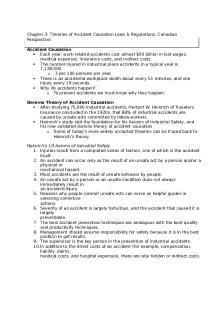Chapter 3 PDF

| Title | Chapter 3 |
|---|---|
| Author | Tra Nguyen |
| Course | Cognitive Psychology |
| Institution | University of Houston-Downtown |
| Pages | 2 |
| File Size | 63.8 KB |
| File Type | |
| Total Downloads | 46 |
| Total Views | 176 |
Summary
Though papers due every chapter....
Description
TRA NGUYEN - PSY 3319
THOUGHT PAPER OF CHAPTER 3
1. Describe a situation in which you initially thought you saw or heard something, but then realized that your initial perception was in error. (Two examples: misperceiving an object under low-visibility conditions; mishearing song lyrics.) What was the role of bottom-up and top-down processing in this process of first having an incorrect perception and then realizing what was actually there?
In our daily lives, it is very easy to engage in a situation in which we initially thought we saw something but then we realized that our initial perception was in error. And it is like when we misperceiving an object under low-visibility conditions. One time, in twilight, when my car was passed by a rice field, I encountered something from a far distance. I initially thought I saw many farmers there, but when I came closer, I realized that my initial perception was in error because they were just some scarecrows, which got some clothes and hats on. As we all know, one way for people to recognize objects in the environment is to compare the representations of those objects with the templates which stored in our memories. And that is the reason why my brain automatically think of a human when my eyes see something closely to the human shape. This concept above is related to the bottom-up processing. In this process, the information analysis begins with the sensory receptors at first and then works up to the brain’s integration of sensory information. After that, when I came closer and got my mind involve in this information-perceiving process to recognize the straw dummies, the top-down processing was carried on. In this process, information processing is guided by higher-level mental processes, as when we construct perceptions drawing on our experience and expectation. It can be said that bottom-up processing does not require any thinking, while topdown processing necessarily implies an active mind. To make these two processes more clearly and easy to understand, I am going to give one more example of my own. Bottom-up processing happened when one time, I felt something crawling on my arm and, without seeing it, just freaked out. Following with that, top-down
TRA NGUYEN - PSY 3319
THOUGHT PAPER OF CHAPTER 3
processing happened when I saw a spider and stomped on it because of my past experiences with spiders. It can be said that bottom-up processing deals more with assumptions and creating a circumstance due to expectancy while top-down processing, on the other hand, is more of a thought out process due to knowledge. Me with the bottom-up process expected that a spider would be the cause of the sensation on my arm and so reacted. But me in the top-down processing reacted because, based upon fact not expectancy, I knew a spider was nearby. By analyzing two instances of my own, we made clear the role of bottom-up and topdown processing in creating our perception. Perception starts with bottom-up processing, which involves receptors. But perception depends on information in addition to that falling of receptors, including knowledge that a person brings to the situation. However, both of these processes are affected by many factors. So in conclusion, to have an exact perception, we have to gather full details of object, not basing only on our knowledge or expectation....
Similar Free PDFs

Chapter 3 Chapter 3 Chapter 3
- 9 Pages

Chapter 3 - Ch 3
- 13 Pages

3 - chapter 3
- 4 Pages

Chapter 3
- 136 Pages

Chapter 3
- 41 Pages

Chapter 3
- 2 Pages

Chapter 3
- 2 Pages

Chapter 3
- 18 Pages

Chapter 3
- 8 Pages

Chapter 3
- 14 Pages

Chapter 3
- 6 Pages

Chapter 3
- 57 Pages

Chapter 3
- 12 Pages

Chapter 3
- 11 Pages

Chapter 3
- 7 Pages

Chapter 3
- 7 Pages
Popular Institutions
- Tinajero National High School - Annex
- Politeknik Caltex Riau
- Yokohama City University
- SGT University
- University of Al-Qadisiyah
- Divine Word College of Vigan
- Techniek College Rotterdam
- Universidade de Santiago
- Universiti Teknologi MARA Cawangan Johor Kampus Pasir Gudang
- Poltekkes Kemenkes Yogyakarta
- Baguio City National High School
- Colegio san marcos
- preparatoria uno
- Centro de Bachillerato Tecnológico Industrial y de Servicios No. 107
- Dalian Maritime University
- Quang Trung Secondary School
- Colegio Tecnológico en Informática
- Corporación Regional de Educación Superior
- Grupo CEDVA
- Dar Al Uloom University
- Centro de Estudios Preuniversitarios de la Universidad Nacional de Ingeniería
- 上智大学
- Aakash International School, Nuna Majara
- San Felipe Neri Catholic School
- Kang Chiao International School - New Taipei City
- Misamis Occidental National High School
- Institución Educativa Escuela Normal Juan Ladrilleros
- Kolehiyo ng Pantukan
- Batanes State College
- Instituto Continental
- Sekolah Menengah Kejuruan Kesehatan Kaltara (Tarakan)
- Colegio de La Inmaculada Concepcion - Cebu